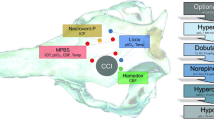Abstract
The injured brain is vulnerable to increases in temperature after severe head injury. Therefore, accurate and reliable measurement of brain temperature is important to optimize patient outcome. In this work, we have fabricated, optimized and characterized temperature sensors for use with a micromachined smart catheter for multimodal intracranial monitoring. Developed temperature sensors have resistance of 100.79 ± 1.19Ω and sensitivity of 67.95 mV/°C in the operating range from15–50°C, and time constant of 180 ms. Under the optimized excitation current of 500 μA, adequate signal-to-noise ratio was achieved without causing self-heating, and changes in immersion depth did not introduce clinically significant errors of measurements (<0.01°C). We evaluated the accuracy and long-term drift (5 days) of twenty temperature sensors in comparison to two types of commercial temperature probes (USB Reference Thermometer, NIST-traceable bulk probe with 0.05°C accuracy; and IT-21, type T type clinical microprobe with guaranteed 0.1°C accuracy) under controlled laboratory conditions. These in vitro experimental data showed that the temperature measurement performance of our sensors was accurate and reliable over the course of 5 days. The smart catheter temperature sensors provided accuracy and long-term stability comparable to those of commercial tissue-implantable microprobes, and therefore provide a means for temperature measurement in a microfabricated, multimodal cerebral monitoring device.









Similar content being viewed by others
References
N. Badjiatia, Hyperthermia and fever control in brain injury. Crit Care Med 37(7 suppl), S250–S257 (2009)
K.H. Polderman, Mechanisms of action, physiological effects, and complications of hypothermia. Crit Care Med 37(7 suppl), S186–S202 (2009)
Y.K. Axelrod, M.N. Diringer, Temperature man nagement in acute neurologic disorders. Neurol Clin 26(2), 585–603 (2008)
Elizabeth MM, Alistair DN, Stephen AB, Rinaldo B. Therapeutic hypothermia: Benefits, mechanisms and potential clinical applications in neurological, cardiac and kidney injury. Injury, Int.J. Care Injured, in press, 2011.
C.S.D. Deyne, Therapeutic hypothermia and traumatic brain injury. Curr Opin Anaesthesiol 23, 258–262 (2010)
J. Verlooy, L. Heytens, G. Veeckmans, P. Selosse, Intracerebral temperature monitoring in severely head injured patients. Acta Neurochir 134, 76–78 (1995)
C.S. Rumana, S.P. Gopinath, M. Uzura, Brain temperature exceeds systemic temperature in head-injured patients. Crit Care Med 26, 562–567 (1998)
L. McIlvoy, Comparison of brain temperature to core temperature. J Neurosci Nurs 36, 23–31 (2004)
T. Tokutomi, K. Morimoto, T. Miyagi, S. Yamaguchi, K. Ishikawa, M. Shigemori, Optimal temperature for the management of severe traumatic brain injury: effect of hypothermia on intracranial pressure, systemic and intracranial hemodynamics, and metabolism. Neurosurgery 52, 102–111 (2003)
C.D. Kurth, J.M. Steven, Keeping a cool head. Anesthesiology 93, 598–600 (2000)
C.D. Kurth, M.M. O’Rourke, I.B. O’Hara, Brain cooling efficiency with pH-stat and alph-sat cardiopulmonary bypass in new-born pigs. Circulation 96, II-358–II-363 (1997)
K.N. Fountas, E.Z. Kapsalaki, C.H. Feltes, Intracranial temperature: is it different throughout the brain? Neurocrit Care 1, 195–1999 (2004)
C. Li, J. Han, C.H. Ahn, Flexible biosensors on spirally rolled micro tube for cardiovascular in vivo monitoring. Biosens Bioelectron 22, 1988–1993 (2007)
C. Li, P.M. Wu, J. Han, C.H. Ahn, A flexible polymer tube lab-chip integrated with microsensors for smart microcatheter. Biomed Microdevices 10, 671–679 (2008)
C. Li, P.M. Wu, W. Jung, C.H. Ahn, L.A. Shutter, R.K. Narayan, A novel lab-on-a-tube for multimodality neuromonitoring of patients with traumatic brain injury (TBI). Lab Chip 9, 1988–1990 (2009)
C. Li, L.A. Shutter, P.M. Wu, C.H. Ahn, R.K. Narayan, Potentail of a simple lab-on-a-tube for point-of-care measurements of multiple analytes. Lab Chip 10, 1476–1479 (2010)
B.G. Lipták, Process measurement and analysis. CRC Press, 690 (1995)
J.L. Thomas, Precision resistors and their measurement. Natl Bur Stand Circular 470, 13 (1948)
T.Y. Chang, V.G. Yadav, S.D. Leo, A. Mohedas, B. Rajalingam, C.L. Chen, S. Selvarasah, M.R. Dokmeci, A. Khademhosseini, Cell and protein compatibility of parylene-C surfaces. Langmuir 23, 11718–11725 (2007)
J.P. Seymour, Y. Elkasabi, H. Chen, J. Lahann, D.R. Kipke, The insulation performance of reactive parylene films in implantable electronic devices. Biomaterials 30(31), 6158–6167 (2009)
F.A. Duck, Physical properties of tissues: a comprehensive reference book (Academic, San Diego, 1990)
P. Liu, R. Zhu, R. Que, A flexible flow sensor system and its characteristics for fluid mechanics measurements. Sensors 9, 9533–9543 (2009)
S. Kim, P. Tathireddy, R.A. Normann, F. Solzbacher, Thermal impact of an active 3-D microelectrode array implanted in the brain. IEEE Trans Neural Syst Rehabil Eng 15(4), 493–501 (2007)
Acknowledgments
This work was supported by the US Department of Defense under project No. PT090526P4 (W81XWH-10-1-0978). The authors gratefully acknowledge Mr. Joseph A. Green at the North Shore University Hospital for performing polyethylene gas sterilization and Dr. Nadeen Chahine and Ms. Neena Rajan at the Feinstein Institute for Medical Research for their valuable discussion.
Author information
Authors and Affiliations
Corresponding author
Rights and permissions
About this article
Cite this article
Li, C., Wu, PM., Wu, Z. et al. Brain temperature measurement: A study of in vitro accuracy and stability of smart catheter temperature sensors. Biomed Microdevices 14, 109–118 (2012). https://doi.org/10.1007/s10544-011-9589-4
Published:
Issue Date:
DOI: https://doi.org/10.1007/s10544-011-9589-4




